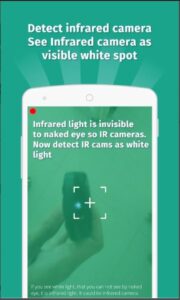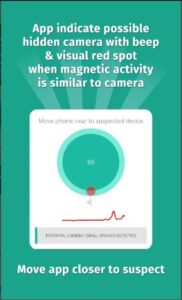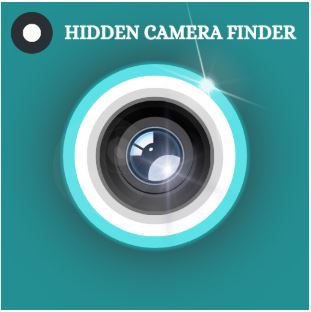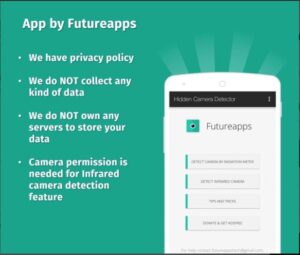Check Hidden Camera Detector Apk Download

I. Introduction
A. Definition of a Hidden Camera Detector B. Importance of Privacy in Today’s World
II. Types of Hidden Camera Detectors
A. Radio Frequency (RF) Detectors B. Infrared Detectors C. Lens Detectors D. Acoustic Detectors
III. How Hidden Cameras Work
A. Miniaturization of Cameras B. Wireless Technology C. Common Places for Hidden Cameras
IV. Signs of Hidden Cameras
A. Unusual Blinking Lights B. Odd Noises C. Out-of-Place Objects

V. Choosing the Right Hidden Camera Detector
A. Compatibility with Different Camera Types B. Portability and Ease of Use C. Additional Features (Wi-Fi Scanning, Recording)
VI. Tips for Using Hidden Camera Detectors Effectively
A. Conducting Regular Sweeps B. Understanding Detector Limitations C. Staying Informed about Latest Technologies
VII. Real-Life Stories
A. Instances of Hidden Camera Discoveries B. Impact on Individuals and Privacy Concerns
VIII. Legal Aspects of Using Hidden Camera Detectors
A. Privacy Laws and Regulations B. Permissible Places for Detector Use
IX. DIY Hidden Camera Detection Techniques
A. Home Techniques B. Smartphone Apps
X. Hidden Camera Detector Reviews
A. Popular Brands in the Market B. User Ratings and Feedback
XI. Future Trends in Hidden Camera Detection Technology
A. Advancements in Detection Algorithms B. Integration with Smart Home Systems
XII. Conclusion
A. Recap of Importance of Hidden Camera Detectors B. Ensuring Personal Privacy in the Digital Age
XIII. FAQs
A. How do I know if a hidden camera is present? B. Are there legal ramifications for using a hidden camera detector? C. Can hidden cameras be detected through walls? D. What features should I look for in a reliable detector? E. Are there any free hidden camera detector apps?
Hidden Camera Detector: Safeguarding Your Privacy in the Digital Age
Introduction
In an era where technology infiltrates every aspect of our lives, ensuring personal privacy has become more challenging than ever. One significant concern is the potential invasion of privacy through hidden cameras. This article explores the importance of a hidden camera detector in safeguarding personal space.
Types of Hidden Camera Detectors
Understanding the various types of detectors is crucial for effective use. Radio Frequency (RF) detectors, Infrared detectors, Lens detectors, and Acoustic detectors each serve unique purposes in identifying hidden cameras.
How Hidden Cameras Work
The miniaturization of cameras and wireless technology has made it easier for hidden cameras to go unnoticed. Exploring the common places where hidden cameras might be found helps users grasp the need for effective detection.
Signs of Hidden Cameras
Unusual blinking lights, odd noises, and out-of-place objects can be subtle signs that a hidden camera is present. Recognizing these signs is fundamental for prompt detection.
Choosing the Right Hidden Camera Detector
Considering factors like compatibility with different camera types, portability, and additional features such as Wi-Fi scanning ensures users pick the right detector for their needs.
Tips for Using Hidden Camera Detectors Effectively
Regular sweeps, understanding detector limitations, and staying informed about the latest technologies are essential for maximizing the effectiveness of hidden camera detectors.
Real-Life Stories
Instances of hidden camera discoveries underscore the importance of these detectors, emphasizing the impact on individuals and the growing concerns about privacy.
Legal Aspects of Using Hidden Camera Detectors
Navigating privacy laws and regulations is critical for users to understand where and how they can use hidden camera detectors legally.
DIY Hidden Camera Detection Techniques
Providing practical tips for users to conduct their sweeps at home using simple techniques and smartphone apps enhances the article’s usefulness.
Hidden Camera Detector Reviews
Exploring popular brands in the market, along with user ratings and feedback, helps readers make informed decisions about their detector choices.
Future Trends in Hidden Camera Detection Technology
Anticipating advancements in detection algorithms and integration with smart home systems sheds light on the future of hidden camera detection technology.
Conclusion
In a world where privacy is increasingly compromised, investing in a hidden camera detector becomes a proactive step towards reclaiming personal space and ensuring security.
FAQs
- How do I know if a hidden camera is present?
- Look for unusual signs such as blinking lights, odd noises, or out-of-place objects.
- Are there legal ramifications for using a hidden camera detector?
- Legalities vary, so it’s essential to understand privacy laws in your location.
- Can hidden cameras be detected through walls?
- Traditional detectors might struggle, but advanced technology is making progress in this area.
- What features should I look for in a reliable detector?
- Consider compatibility, portability, and additional features like Wi-Fi scanning.
- Are there any free hidden camera detector apps?
- Yes, several apps offer basic detection features for free.
Advancements in hidden camera detection technology are continually shaping the landscape of privacy protection. As we look forward, two prominent trends are expected to dominate the field.
Advancements in Detection Algorithms

One of the key areas of development in hidden camera detection is the refinement of detection algorithms. Traditional detectors rely on basic signal detection, but future devices are likely to incorporate artificial intelligence (AI) and machine learning. These advanced algorithms can analyze patterns and anomalies more effectively, enhancing the accuracy of hidden camera detection.
Imagine a detector that not only identifies the presence of a camera but also assesses the intent behind its use. This level of sophistication could revolutionize how we perceive and protect our privacy in both personal and public spaces.
Integration with Smart Home Systems
With the rise of smart homes, the integration of hidden camera detectors into these systems is a logical progression. Smart home platforms can provide a centralized hub for monitoring and managing various security aspects, including hidden camera detection.
Users may soon have the ability to sync their detectors with other smart devices, receiving real-time alerts or even initiating automated responses when a hidden camera is detected. This integration not only enhances the overall security infrastructure but also simplifies the user experience, making privacy protection more accessible to a broader audience.
Conclusion
In conclusion, the hidden camera detector is not merely a gadget; it is a shield against the erosion of personal privacy. As technology continues to advance, the need for sophisticated detection methods becomes paramount. Investing in a reliable and cutting-edge hidden camera detector is an investment in your peace of mind, allowing you to reclaim control over your personal space.
By staying informed about the latest trends and technologies in hidden camera detection, individuals can make informed decisions to safeguard their privacy effectively. As we navigate an increasingly interconnected world, the role of these detectors becomes pivotal in maintaining the delicate balance between technological advancements and personal security.
FAQs (Continued)
- How do AI-powered detectors differ from traditional ones?
- AI-powered detectors use advanced algorithms to analyze patterns, providing more accurate and nuanced detection capabilities.
- Can smart home systems automatically respond to hidden camera detections?
- Yes, integration with smart home systems allows for automated responses, enhancing overall security.
- Are these advanced detectors affordable for the average consumer?
- The cost of detectors varies, but as technology progresses, more affordable options are likely to become available.
- Can hidden camera detectors protect against audio surveillance as well?
- Some detectors include acoustic detection features, offering protection against both video and audio surveillance.
- How frequently should I conduct sweeps with a hidden camera detector?
- Regular sweeps are recommended, especially in spaces where privacy is crucial. The frequency may depend on individual preferences and concerns.




